
Random Lincoln's Sparrow #birding
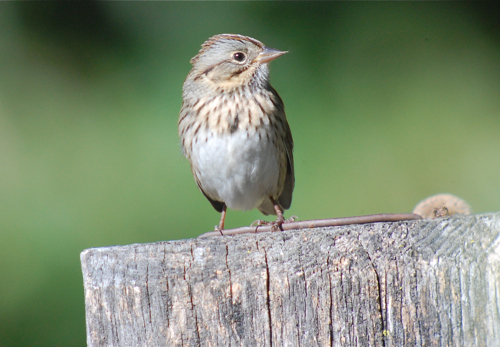
Jupiter Again
Last night I tried to take pictures of Jupiter through my spotting scope again. A few days ago, I had pretty good luck getting the moons around Jupiter, but I wanted to try and get the cloud bands on the planet itself. I didn't have the best of luck. I was out at Mr. Neil's with Lorraine, Non Birding Bill stayed home. I spent the night because I needed to grab some beehive frames and take them to a Twin Cities nature center today so they can be used for programs. The center does a honey extraction program this time of year and they didn't have enough frames for demonstration, so I was glad we could loan a few to help them out. Not only are we helping a friend, but someone else will extract our honey for us--that's a win-win if you ask me.

So, I set up my scope on Jupiter and enjoyed the fall night--the heavy smell of pine, the quiet peeps of small birds migrating in the night...and the few random wood frogs giving it one last go before the cold forces them underground. The above photo made the planet look more like cell division rather than Jupiter. That was from hand holding the camera, so I tried using the timer on the camera while it was attached to the scope to reduce shake.

Hm...that setting didn't work. You can make out Jupiter and it's moons...but it looks rather...phallic.

Oh my...the moons took on a rather different shape...uh...wow...

Well, wow. That just...all I can say is that clearly, my mind was not on astronomy...and possibly that I was missing NBB.

I did get one very grainy photo of jupiter and you can kind of make out the cloud bands. I think I'll stick to digiscoping birds.
Digiscoping Jupiter
If you follow astronomy, Jupiter is very bright in the evening sky. I thought I would see what I could do with my Swarovski spotting scope. I aimed it and at 20 power magnification, I could easily make out the planet Jupiter and four of its moons. I was even able to digiscope it with my Nikon D40:

I managed to capture it--a bit shaky but still, you can make out the large planet and two moons on either side. My eyepiece zooms up to 60 power and when I did that, you could actually make out the cloud rings on Jupiter. Alas, I was not able to digiscope that but it's cool to know that the spotting can be used for more than just birds.
Migration, Carlos Avery and a Pub Quiz
Merlin's Rest put out the call for Guest Pub Quizzers and I'll be leading the Pub Quiz this Sunday, September 19 at 7:30 pm. If you know me and the blog, you have an idea of what kinds of quesitons I'll ask, but I do promise that it will not all be bird related. I'll have some cool prizes...perhaps even some honey from our hives for the winning team.

I keep trying to deny autumn this year and I can't. I took this photo two days ago at Carlos Avery Wildlife Management Area. One can't deny red oak leaves as a sure sign that it's getting colder and the days are getting shorter. My denial was broken in full yesterday when we went on a canoe/kayak paddle in my park for work...it was a tad chilly on the river and my fingers had that dry skin ache that is exclusive to cold, dry air. Sigh. I did get one pleasant reminder of fall--Mr. Neil's housekeeper called to say that they found a 20# patch of Hen of the Woods in our usual patch--my favorite wild edible. We will have some tasty soups and sauces with that fungus this winter!

Canada geese are on the move and I got word that my waterfowl surveys start soon--at the end of the month. My route got expanded this year, but I'm also nervous. I went on a ride along for this new extension last year and the amount of ducks and species mix is a lot to take in. Will I be able to count them all? We'll do our best but I feel this year's survey is of utmost importance. When we do this again for the next few years? Will those numbers change with the Gulf spill? Despite "capping of the well" the spill is not over, there's still a ton of oil in the water, it's below the surface so you can't see it, but it's affecting the food supply.
Of large concern to me is the recent fish kill in Louisiana, Check out This Is Not A Road. Disturbing amount of fish and also interesting that in this fish kill it's several species of fish. I've seen fish kills--we get them along the Mississippi in spring and even on some of our lakes, but it's usually one species of fish. This huge fish kill in Louisiana is SEVERAL species and includes sting rays and a whale. The government says that the oil spill is not the cause even though oil is clearly visible on the fish in close up shots. They official report is depletion of oxygen...which happens this time of year and does cause fish kills but usually not this large and the depletion is caused by the dead zone in the Gulf (created by fertilizer pollution from farmers on the Mississippi River) and most likely exacerbated by the oil and more likely the chemical oil dispersent put in the Gulf). There's a great report on the fish kill from the AP on YouTube and an explanation on New Scientist. I think we'll see more problems.
Sorry for that tangent. I'm not exactly sure what to do about the oil spill. I want people to know that it's still a problem and that many birds (and other coastal creatures, not to mention people's jobs) are in peril, but I don't want this blog to become your daily downer. Just promise me you won't buy into the idea that oil spill is over and we still have problems to solve, 'k?
Back to birds:

There's a feed plot at Carlos Avery and I chuckled at this goldfinch, it was eating the tassels. I know finches are primarily seed eaters and I've recently learned that they eat all matter of plants, but I'm beginning to suspect that there's not a piece of vegetation they won't eat. I do have to hand it to them as far as creativity. You pheasants and your bobwhite go for the corn kernels, goldfinches go tassels. Great way to avoid competition.

Warblers, like the above yellow-rumped warbler were flitting among the tassels too. The appeared to be after tiny insects rather than the plants themselves.

All the grasses and shrubs along the road were alive with small birds. If you could see their shadows rustling among the leaves, you could hear their contact chip notes. A little pishing (for non birders, say the word "pish" only in a loud whisper) made some of them pop up to investigate the sound. Above are some swamp sparrows (the one on the left looks like its still molting heavily).

I love swamp sparrows and they blend so well with the changing fall foliage. I especially love it when see a sparrow head on, they look like cranky old mean with muttonchops. I almost feel like this one should shouting in a wheezy voice, "Hey you, whipper snapper, quit that pishing racket!!" As I was taking their photos, I could hear sandhill cranes calling in the distance and I noticed that they were flying above me:

I would guess that this is a family group of cranes. Perhaps they were doing some laps, getting their wing muscles in shape and teaching the young birds the mysteries of finding a warm column of air spiraling up to glide in. Those thermals save energy when on long journeys.

These cranes are far enough south that they have avoided the Minnesota sandhill crane hunt, but depending on their route, they will have to watch out for the hunts in Kansas and Texas as well. Good luck, cranes.
Digiscoping Tip Video
My buddy Dale over at Discovering Alpine Birds has been making a series of videos for digiscoping tips. This is a great video in an easy to understand format and it's short--so you don't get overwhelmed with too much info (something that happens to me when people start explaining photography to me). [youtube]http://www.youtube.com/watch?v=yTFmonpa7cg[/youtube]
Digiscoping Skydivers
 Last week, my neighbor Zoe mentioned she was going to go skydiving with some friends. We've known a few people who have done it and they always seem to end up with a cool video marred by cheesy music like Kenny Loggins waxing musical about the "Danger Zone." Zoe mentioned that she probably would not buy the video and I offered to come along an try to digiscope her with my Swarovski spotting scope and Nikon D40.
Last week, my neighbor Zoe mentioned she was going to go skydiving with some friends. We've known a few people who have done it and they always seem to end up with a cool video marred by cheesy music like Kenny Loggins waxing musical about the "Danger Zone." Zoe mentioned that she probably would not buy the video and I offered to come along an try to digiscope her with my Swarovski spotting scope and Nikon D40.

I arrived early to Skydive Twin Cities (which oddly enough actually jumps in Baldwin, WI) and watched some of the other skydivers and practiced on them. The only thing that was a bummer was the overcast sky. Had it been a sunny day, these shots would have been killer. With my scope, many assumed I was the staff photographer and asked for requests (even though I was dress rather unprofessionally in my MN Roller Girls hoodie).

I thought it would be harder to find the jumpers with my scope, but the colorful chutes were large enough and circled in a fairly predictable pattern that I was able to get the shots I wanted for the most part.

Here's another practice shot. As jumpers were coming down, I realized that they were going up in groups of 6 - 8 and that it would help a great deal if I knew the color of chute to concentrate on my friends as they came down. We did talk to the instructors who would come down with and my friends and they told us the colors and I noted that jumpsuits--my friends had on lighter colored suits so I would be able to find them easier with that too. I did find it amusing that all of the instructors smoked like chimneys between jumps. I supposed if you jump out of a plane 8 times a day, lung cancer doesn't seem that threatening.

It finally came time for my friends to jump and I followed their plane with my scope. Having watched it a few times, I knew the general route the plane would take.

And I was able to digiscope the plane! It was a bit easier to get a plane in flight than a bird--not as likely to get distracted by prey below it like a goshawk would. So I kept my scope on it and my camera at the ready. For the most part, people had left me alone when I was practicing getting shots on the other jumps. This time, when I really needed to concentrate, people started asking me questions or even asking for photo requests of friends. I was probably a little terse in my answers and finally said something to the effect of, "I've been paid privately by other jumpers to focus on them and no one else."

I almost lost the plane a few times as it was right overhead and disappeared in the cloud cover, but I managed to get the last two people jumping from the plane. Turns out the last two to leave the plane were my neighbor and my friend Ben. Above is Zoe free falling and Ben is about to leave the plane--you can see his limbs hanging out the side.

And here goes my friend Ben. Both of these photos were digiscoped from the ground while the plane was at 13,000 feet! Pretty darned cool! Again, I'm bummed with the cloudy and dark conditions but at least these are souveneir photos for my friends.

Here are a couple of other free fallers. These ended up being the camera guys who film you during the jump.
 Here are my friends coming down. That's Ben in front and Zoe in back. Incidentally, that Ben is Ben San Del a local stand up comedian--he's very funny, I loved his show this summer A Nice Guy's Guide to Awkward Sex. Non Birding Bill and I are going to watch him open for Emo Phillips in November. Perhaps he will work in some skydiving humor? The instructor told me the wrong color for Ben's chute but thanks to my scope's clarity, I was able to pick out in his chute early on.
Here are my friends coming down. That's Ben in front and Zoe in back. Incidentally, that Ben is Ben San Del a local stand up comedian--he's very funny, I loved his show this summer A Nice Guy's Guide to Awkward Sex. Non Birding Bill and I are going to watch him open for Emo Phillips in November. Perhaps he will work in some skydiving humor? The instructor told me the wrong color for Ben's chute but thanks to my scope's clarity, I was able to pick out in his chute early on.

This has opened up a new world of digiscoping to me. I hope to go back on a sunny day--sounds like Ben and Zoe are game to do it again. Apparently, when it comes to skydiving, no one does it twice. You either do it once and never again or you do it for the first time and come completely addicted.
What other non birding things can I digiscope?
The Birds That Got Away
 One of the things I was counting on to give me an edge over Clay in our Digiscoping Duel was this mountain ash tree (or rowan as Mr. Neil calls it). It's ripe and the berries time perfectly with fall migration.
One of the things I was counting on to give me an edge over Clay in our Digiscoping Duel was this mountain ash tree (or rowan as Mr. Neil calls it). It's ripe and the berries time perfectly with fall migration.

This tree can be loaded with all sorts of birds like the above female rose-breasted grosbeak and I did get shots of cedar waxwings right away, but as soon as the contest was over, all sorts of species flew in for a feast. The light hit the tree perfectly, so I stuck around after the contest was finished to get some shots.

Of course there were more waxwings. My first photo wasn't bad but they practically seemed to be posing now that the contest was over. Above is an adult cedar waxwing.

The younger waxwings that were hatched this summer will be stripey. If you have waxwings in your neighborhood, take a moment to watch them in your fruit trees--they attack the fruits and berries with such verve. They don't come to bird feeders--they don't seem to have any interest in sunflowers and millet. They will come in to birdbaths and you generally don't get one at a time, you get thirty (at least).

I love watching them gulp berries. These small, slender birds are easy to miss in tree branches. Even their calls blend in well if you are tuned into them. Here's a link to waxwing calls so you can know what they sound like.

Among the waxwings was this Tennessee warbler (dude, where were you during the digiscoping challenge--arg). Especially after the dreadfully blurry and ghostly image of that black and white. Ah well, win some, lose some.

Too small to grab a whole ash berry and gulp it, this bird used its dainty bill to pierce the skins to get at the juice on the inside.

The next bird that popped up was a male scarlet tanager already in his winter plumage--really, tanager, you're killing me here. I will say this, even though I tried to use a fence and bush to break up my silhouette from the sun behind me, it felt very cagey with my scope aimed on it. It ate three berries and flew off.

Even though I already had a photo of an eastern bluebird, I was sorry I couldn't use this shot of a juvenile molting into its adult plumage.

Here was another heart-breaking shot--far better than the image I got during the actual contest of a red-eyed vireo. Alas. I still had a tough time getting a shot of this bird. Vireos are known for their ability to flit about the top of a tree canopy and sing nonstop. The bird kept moving around so much in the tree that it had trouble stopping long enough to eat some berry. I always thought accipiters like Cooper's hawks and goshawks were ADD birds, but I suspect the vireo is even worst. Constant movement is a good strategy--good way to sneak up on insects and confust potential predators. Just makes going for stationary berries a challenge.
This tree is a good example of providing food for birds and other wildlife in your yard besides just bird feeders and water sources and it's part of what makes Mr. Neil's yard so fun for me to watch birds in and take their pictures.
To see more photos of the Digiscoping Duel, check the Flickr Album.
Goldfinch Looking Rough
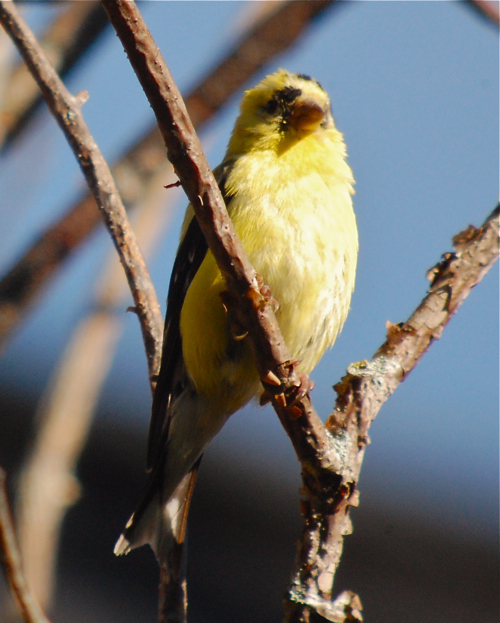 It looks as if the above goldfinch might say in a Krusty the Clown sounding voice, "Ugh, I just had one helluva bender last weekend."
It looks as if the above goldfinch might say in a Krusty the Clown sounding voice, "Ugh, I just had one helluva bender last weekend."
Fall molting is kicking in and our lovely golden yellow male goldfinches are losing their breeding plumage into their more camo friendly dull olive color. At least we will see them all winter, they may not be yellow, but they will be here.
Digiscoping Duel Results
The results are in from the first ever Twitter Digiscoping Duel:
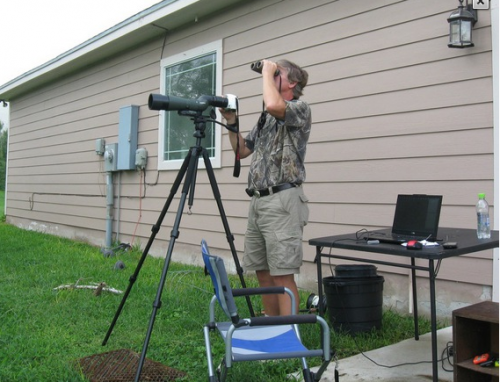
My buddy, Clay Taylor of Swarovski Optik digiscoped from his yard in Texas and he posted photos of 31 species.
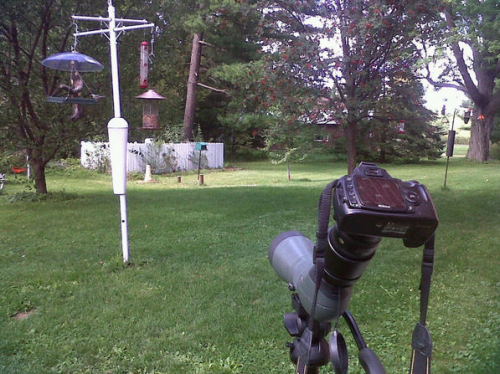
I set myself up at Mr. Neil's yard with the above digiscoping setup--lots of birds and easy Internet access. Alas, my final total was 28 birds. Cornell was kind enough to say, "But should there be a correction for higher diversity in TX," but I think that weather and internet connection can help even out the competition--there were 3 very common birds that I expected to get and did not: blue jay, pileated woodpecker and turkey vulture. I won't post all 28 photos, but I'll post some highlights below:
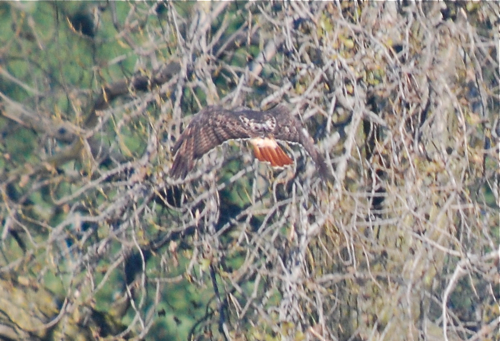
My first shot of the day was a red-tailed hawk flying away. I found another red-tail perfectly perched in great light later in the day, but I really liked the way you can see the rusty red tail on this guy. Besides, Clay and I weren't going for art, we were going for identifiable photos and well, it doesn't get more identifiable than that with a red-tailed hawk.
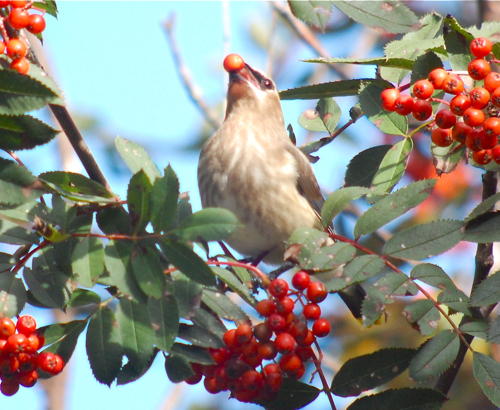
Early in the morning, things were going swimmingly. The showy mountain ash tree around the feeders was ripe and attracted loads of waxwings. I expected warblers and vireos would soon follow (the tree eventually did follow this pattern...after the contest was over).
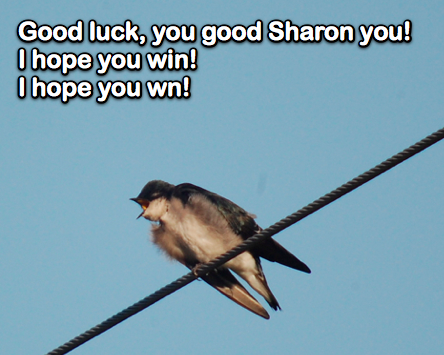
As I loaded up photos here and there on Twitter, I even got a little cocky and added some captions. The above caption with the tree swallow was for Non Birding Bill and a nod to Jack Lemon from the movie The Great Race. I really enjoyed being able to interact with people throughout the contest. It was like being sequestered during a bird-a-thon or at the World Series of Birding. I could see what Clay was up to and see comments on photos...and even answer a couple of bird questions.
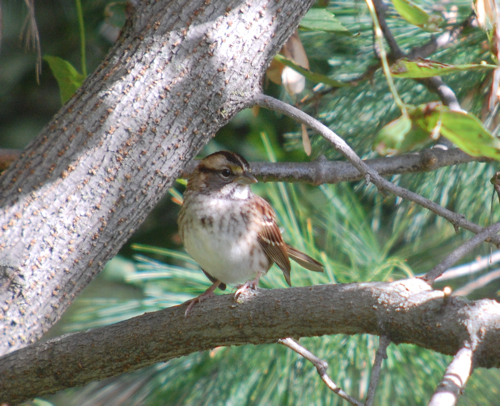
I did find the flocks of white-throated sparrows a bit sobering. A week ago today it was 92 degrees F. When I started today, it was blustery and in the 40s. And these sparrows are a sure sign of fall. Sigh.
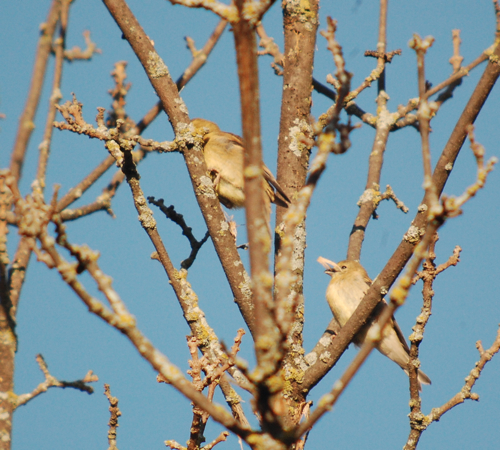
I did see some crazy stuff going on, like the above immature goldfinches stripping off bark from a dead tree and eating it. I checked Cornell's Birds of North America Online and bark stripping is one of the many things goldfinches will eat.
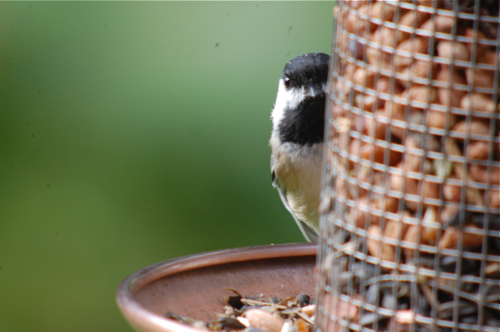
When it came to the common feeder birds, I tried to get interesting shots--like the above black-capped chickadee. It's as if it's stalking me...and perhaps plotting my demise.
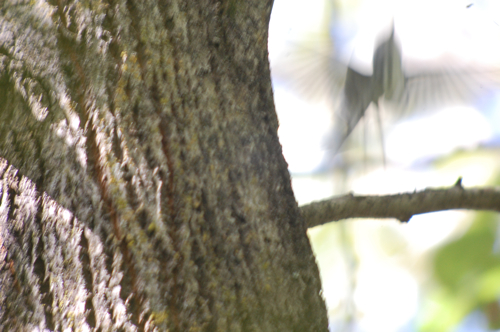
Not all of my photos were worth writing home about. I'm pretty sure that this is the worst shot of a black and white warbler in recorded history. I posted it as a joke and Clay let it go through, he said he could kind of see a black and white warbler...he was too kind.
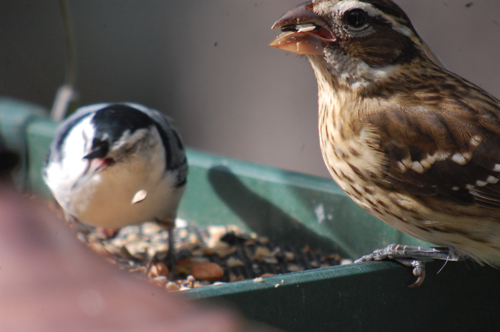
Here's a candidate for Awkward Family Photos. What is that nuthatch doing--sneezing? Flipping seeds? Swearing? Either way, the rose-breasted grosbeak appears uninterested.
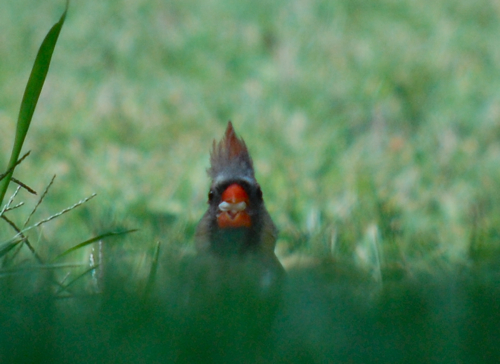
All in all it was a great time and I hope we can do something like this again.
Some of my favorite shots that Clay got are his zone-tailed hawk, yellow-breasted chat, purple martin, royal tern and his winning final bird Mississippi kite. He's got mad skills with birds in flight and digiscoping not to mention a crazy bird yard in Texas.
To see more photos from the day of the Digiscoping Duel visit the Flickr Album.
